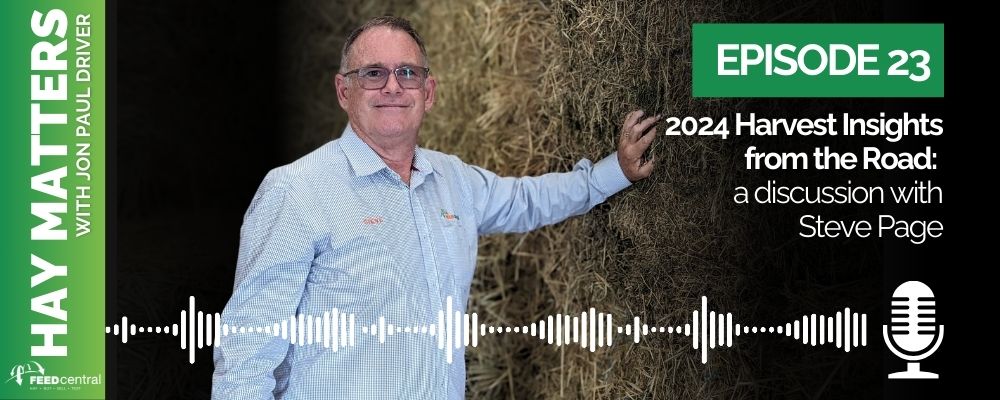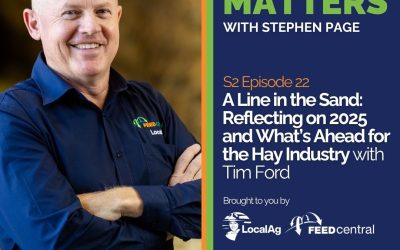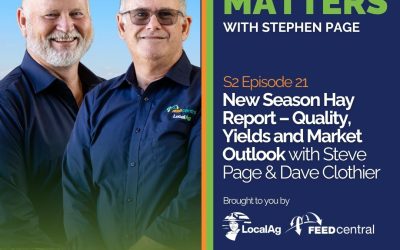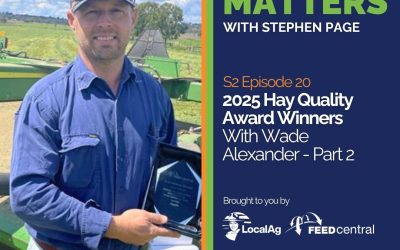
Podcast Highlights
In the latest Feed Central Hay Matters Podcast, Host Jon Paul Driver talks to Steve Page, Grower Services Manager, about the challenges faced by hay producers during a season marked by wet weather, frost events, and fluctuating market dynamics. Steve, who has recently been on the road visiting growers, shares insights into what the season looked like and the impact of these challenges across Australia.
- Southern Queensland and northern New South Wales experienced a wet baling period, resulting in quality deterioration.
- The Riverina faced frost damage, while Wimmera-Mallee growers shifted to 100% hay production but reported reduced yields.
- South Australia endured one of its toughest seasons in decades, with little surplus hay available for domestic markets.
- Of the cereal hay inspected, only 1% achieved AA grade, while most fell into high B or C grades due to weather impacts.
- Lucerne hay production is increasing as growers shift away from seed due to weak global markets, filling gaps left by a shortage of protein hays.
- Many growers are storing high-quality hay to sell in early 2025, while C-grade hay is being sold to avoid further deterioration.
Steve recommends growers monitor their hay quality, wait for the right market conditions, and consider Feed Central’s quality certification services to optimise sales opportunities.
Read Transcript
Unknown Speaker 0:00
Music.
Jon Paul Driver 0:05
Welcome to the Feed Central Hay matters podcast, your go to source for all things hay related in Australia, I’m your host. Jon Paul driver in today’s episode, we’re joined by Steven page. Steven is the Grower Services Manager for Feed Central. Welcome back to the podcast.
Unknown Speaker 0:22
Hi, John Paul,
Jon Paul Driver 0:23
What’s new in the Australian hay market? I understand you’ve had some wet weather.
Unknown Speaker 0:29
Yeah. Jon Paul, up in the in the north here, Southern Queensland, northern New South Wales, it’s been an extremely wet period through there. We’ve had some of our creeks sort of in flood and that type of thing. It made the actual hay baling period through here quite wet, so quite difficult. There was some reasonable quality hay made early, but then we started to get rain in that mid September period, and the quality deteriorated then, from then on, really, and people struggle to really get it in a bale of any, any sort of quality. It’s hasn’t been the easiest period through this region. But further south, even though they, you know that central New South Wales, they also experienced rain through the baling period. Again, there were a few growers that got some early stuff made and and got it, you know, in good quality. But again, the majority of it has had some rain. And those fellas in that area also, they had, you know, beautiful crops. There was some beautiful crops around Dubbo, south of there, through that, you know, Griffith area and that type of thing. Riverina area was absolutely massive. Crops through there, they also experienced the Riverina area then got a frost, and it caused some damage to the grain side of things. And then also, then they started bailing or cutting, and they got a bit of rain on also some of that stuff that. So they really did have a bugger of a period, sort of to make hay through there, but there was some reasonable quality made. And then further south of that, going down onto that Murray along the Murray River, on the New South Wales Victorian border, not as good of not as high as production. And even though they did have a bit of rain on theirs, it was still made some reasonable quality hay through there. Their rain tended to be shorter period. It only really they had one storm sort of go across there good conditions after, and it didn’t damage the hay as much. So we’ve seen some reasonable quality hay come off along that river area. And then you go into the Wimmera Mali country. Again, they had an extremely dry growing period. So the crops were quite small. People there have and then they also got frosted growers through there. They, rather than only normally producing in their rotation about 20% of hay, quite a bit of that properties through there were they cut 100% for hay. They still had smaller wind rows. They got right a little bit of rain on it, but again, it didn’t do a lot of damage to it. So there is still some quality hay that came out of that region, though, production is well and truly back where growers normally cut about 20% of their place this year, they’re cutting 100% and they still didn’t make as much hay as they would normally make in the same sort of year. And then South Australia. Well, South Australia, as we’ve probably talked about in the past, we had contractors that moved from South Australia this year into New South Wales and came over to do the baling over here, because they had nothing there to make at all, and the crops were absolutely devastated by such a difficult year over there. We don’t expect any hay to come out of that region at all this year on for the domestic market. Anyway, everything made over there will be swallowed up by their own requirements.
Jon Paul Driver 4:04
And what about export in the balance, thinking about western Victoria and South Australia?
Unknown Speaker 4:10
Yeah, well, those, those exporters, are going to struggle to find the hay that they require. And they, they did venture into some of that area. I went into the Menindee Lakes there a couple of times, and we also had one of our salesmen, Alex Smith, go into that area. That’s an incredible area. Don’t know how much you know of that area, but it’s those lakes only flood once every 10 years, and what they do is they actually grow a crop. As the waters recede, they actually then plant around those lakes, and they’ll get two years of production out of there. Every 10 years, they’re only allowed to grow one crop out of there, and that lake sort of area in that one event. So it, it is absolutely phenomenal. Like, yeah, it’s, it’s an incredible region and great people. Up there, so, but their yields out there were over 10 ton to the hectare of hay, and beautiful hay, thank goodness in the last few and well, since the last actual production of hay out in that region, quite a number of those growers have actually put up sheds, so there’s reasonable quantities of storage out there and quality. Yes, it’s absolutely incredible having a look at that region again. I I went out there 10 years ago with a different job and saw that region, and have been back in there this year. And it’s great to so those growers that I met 10 years ago are still there and still doing the job in there. So it was lovely to spend the time back in that region again. And as I say, the quality of the hay was absolutely magnificent. A lot of that hay is organic, and there are a number of those exporters in that region buying that hay too. So there’s still a bit, there’s still a bit left there in sheds ready to be marketed, but they’re not in a hurry to do it. And that’s what we’ve found out. You know, with the majority of the area, majority of the sheds were empty. There was very little carry over hay this year, and a lot of the growers that have made quality hay have got it stored, have had it inspected, or still waiting to get it inspected, looking at waiting to the new year, because they’re not in a hurry to market it. So we’ve still got quite a bit of hay to inspect later on. They’re waiting. They’re happy to wait for their inspections in January, February, and then look at getting it marketed then, and others that we have inspected, putting a price on it, but not in a hurry to sell.
Jon Paul Driver 6:41
Let’s go through species by species, if you would. Is there a difference in oat and hay and vetch, and lucerne.
Unknown Speaker 6:49
In the quality side of things? Look about on the system. At the moment, we’ve got about 170,000 ton that’s been actually inspected and is active and/or advertised on on our site at the moment, quality wise. On the cereal side of things, the cereal makes up about 45% of what we’ve presently got in the system. Of that the FCAA grade, which is our highest grade. Of course, there’s only about 1% has made that double A grade. The FCA grade about 30. 35% has made that B grade is about 45% has got to the B grade. But a lot of that FCB grade is quite high FCB grade. And the reasoning for that is the the actual visual scoring was, you know, if it had a rain event on it, very rarely will that hay make an FCA grade. So even if it only had five or 10 mil on it, it won’t make an FCA grade. So it’s the FCB grade is still of a high quality. But then we had stuff like in that northern New South Wales, Central New South Wales, that had those big falls of rain on it are FCC grade. And there’s about 20% of that in our system that, yeah, is FCC grade on the vet side of things, we’re well and truly back on our normal production in vets. So the vetch has really been the area in vets. This year was well and truly back. The lupins and the lentils have really cut into that vetch area that was normally planted. And there’s normally a lot of vetch that comes out of that wimb Malley country, and it had a very ordinary season. So not only were we well and truly back on the area planted to vetch, but we were well and truly back also on the yields, we have been a little bit fortunate in a lot of that year. A lot of that actual quality, visual inspection quality from the vets is still an FCA grade or a high FCB grade, but we are very short of vetch, so our protein haze at this stage are back, but we’re now coming into the lucerne period, and we’re seeing a lot of first cut and second cut loosen starting to come into the system now, and it’s it’s showing reasonably good quality, and we’re having quite a few of those loosen growers move back into hay production, and that’s due to the issues that worldwide with lucerne seed marketing. So the Saudi market has pulled right out. And as you probably fully know, those lucerne growers are now looking at coming back into the hay market side of things. So I caught up with a number of them on my last trip to just to look at what, and I think the marketing of loosen hay because of the shortage of vet, is going to be more active, yes, yeah, quite advantageous to those loosen hay growers this year, with the actual better season to the wetter conditions that we are looking at having, we. We are looking, I think, with another rain event coming through in the next week or so, there could be quite a bit of more dry land loose and hay hitting the market too. So to fill in some more gaps.
Jon Paul Driver 6:57
Let’s take a look a little into the future here. This rain suggests favorable production on those warm season grasses in northern New South Wales and Queensland, is that right?
Unknown Speaker 8:52
Yes, but very little that normally goes into hay production. We don’t tend to make a lot of those northern pastures into hay. You get your southern pastures, which is down in Southern Victoria and that type of area. But those fellows have had probably their worst season in probably 20 to 30 years. I’m talking right down in the southern area. I went into Millicent when I was on that last trip down in Southern South Australia, and right across into lower Victoria, and they are still struggling. It’s a green drought. It looks it’s a beautiful, pretty area, but there’s not a lot of grasses and that aren’t substantial there. And looking at very little of that Southern pasture production being made down that area this year.
Jon Paul Driver 11:09
How about canola hay? The frosted canola hay?
Unknown Speaker 11:12
Yeah, so there wasn’t a great deal. We did expect quite a bit of because there was such a huge interest in canola hay when that large frost event came across. Think, really our general discussion around that is it needed to be still at the flowering stage, early pods, at the latest. And really that market required that you were going to, you know, it has to go into sheds, because it’s a long term marketing option for a drought situation. We have seen some canola hay come into the system, but not to the extent that we saw a few number of years ago, when we had a huge canola production. It hasn’t eventuated. And a lot of that frosted hay that we thought we were going to get out of that Griffith area, people held off and have continued to go take their crops through to grain. I’m hearing variable sort of yield rates come back through that some have regretted not making hay, and others have and are still in there with their headers, finding out what they what production they did lose. But yeah, some of those areas were quite substantial, you know, again, they were growers, and we’ve got that number of growers there that have made hay and it’s stacked outside. And at the moment, they’re holding the market sort of fairly stable until that clears out. And then those ones that have got sheds and have made quality hay after that. You know, probably in that March, April period, I think we will find the price will, will rise, the hay price will will increase. And those fellas will come onto the market where they’ve got that quality product in the shed. Still don’t think that we’ve actually got enough production in the system there to get us through to the next season without there being some shortage towards the end, especially on the cereal haze. Yeah, the amount that’s actually been stacked outside hasn’t been to the extent we we thought we were going to see. But there is a quantity out there, but has to be, has to be really sold fairly quickly to stop that deterioration in the paddock. The other thing we’ve seen is this wet conditions up in Southern Queensland and northern New South Wales, high, huge yielding crops, as I said, grain crops, and we were expecting a lot of those growers to be making straw for the feed lots and everything like that, a lot of that. Now, I think those growers are reassessing those options. The paddocks are soft. Yeah, the paddocks are soft. The straw quality will be down. They’ve had massive yields. They’ve had, you know, grain yields. It’s been a long, sort of drawn out harvest. A lot of them are tired the actual price of what they’re going to be getting for their straw and the effort to do it, I think majority of those fellas are going to be saying, well, we’re not going to be bothered. We’re only going to damage our paddocks. Let’s leave it there. And so I think the opportunity now for that Southern, or not southern New South Wales, but Central New South Wales region now, coming back into the straw market is quite strong, but that’s possibly something we need to discuss a little bit more with the sales team. But that’s, that’s my opinion, the straw option for the southern Queensland, northern New South Wales has really sort of dropped off substantially.
Jon Paul Driver 14:41
What’s your marketing advice? If you have really nice oaten hay sitting in a shed, what do you do with it?
Unknown Speaker 14:47
I would be waiting. Enjoy Christmas. Have it, have it inspected. Have the quality. Know your quality. Look after it. Make sure that we don’t get a mouse plague. So keep a really good close eye on it, and then just wait. And as I say, it is still, you know, we still have areas of very dry, low production areas. At the moment, we’ve still got good, good numbers of sheep and cattle in the system that are, you know, the prices is fairly still strong with those. I would be waiting just see what happens end of January, early February, reassessing it. Then you know your quality, and you start talking to the sales team then and saying, Okay, and what’s your cash flow? Do I need if you need cash flow? And then let it go out in that period. But as I say, I still don’t think that we’ve got enough hay in the system to carry us through for next season, so I still feel that there is going to be a shortage of it
Jon Paul Driver 15:46
For those lower grades of oaten hay. What’s the marketing strategy?
Unknown Speaker 15:51
If it’s in a shed, you know, your grade? You know, we’ve got a long so we haven’t come to summer yet. We’ve got a long summer ahead of us yet, and a winter before we look at our next production, depending on on where it is. If you’re in northern New South Wales, and it is a mid, mid FCC grade, or worse, it’s basically only straw value. So if you’ve got heavy, good bales in a shed, and it’s down to that FCC grade, and you can get rid of it into the feed lots as a as a straw value. I know it’s not that’s not the best option normally, but if you can clean your sheds out for a better season ahead next year, do if you don’t want to do that, we’ll hold it and hopefully that we can when we do get really short later on, that those those buyers, will come looking for it, but you’ve got to remember that it’s a FCC grade. It’s hasn’t got pretty aroma. It hasn’t got a good appeal to it, visual appeal to it. If you’re trying to get cattle or sheep or anything to eat it, you’ve got to draw them to it, and then you’ve you’ve got to have that aroma that they’re willing to put it in their mouths, you’d have to seriously have a look at that in a shed, whether you want to take the take the risk that it’s going to turn even worse. We cleared out a lot of that stuff before this season that we had, you know, FCB grade low FCB Grade FCC grade stuff that, because it was, there was such a shortage, it did move, and it moved at a reasonably good price. I wouldn’t be really willing to risk that too much. I would be probably looking at trying to get it, get rid of it on that straw market myself.
Jon Paul Driver 17:31
And then on the protein hay side, the growers are in the driver’s seat. If they need cash flow, they can sell it. And if they don’t need cash flow, well, they can speculate and hope that the price appreciates.
Unknown Speaker 17:42
Yeah, we’re very much in the driving seat there. Like, as I say, the vetch production is well and truly back. The only thing that’s going to affect the price on vetch, it will be that if we do get a lot of rain through that area where they can make lucerne hay off dry land, areas that could potentially drive, you know, keep the price stable where it is. I can’t see it falling, but because a lot of that normal part that lucerne dry land, lucerene area isn’t quality loosen, but it fills a spot. You know, the quality lucerene that you come off those river flats or off the irrigated areas is beautiful lucerne and hopefully we’ll see a lot of that come on the market this year, because, yeah, there’s going to be good money for it.
Jon Paul Driver 18:29
I like coming at it at a couple of different angles, looking at the geography and the quality, grades and the species. I think those are all good ways to bisect the marketplace.
Unknown Speaker 18:38
We’ve actually done 60 more inspections in this first quarter of the inspection season. So this season, we start off in September, and we break the years into quarters. And this year, our number of inspections is up 60 on our previous average. So we have had quite a few inspections being done. The team has done really well getting around and getting those done. The feed central business has continued to grow. So we continue to see seasons being increased this last November. Even though we haven’t quite finished November, we’ve actually it’s the second largest month that we’ve ever had.
Jon Paul Driver 19:18
Wow, that’s something that says that growers want to know the quality of their hay, right?
Unknown Speaker 19:24
Yes, they’re out there, and as I say, quite a bit of that hay. There has been quite an amount of hay outside in stacks. So people were out there and they’re understanding and sort of appreciating the Feed Central quality assurance side of things. So they want to get that and then they can then market their hay, or market it through us, or market it themselves. And quite a bit of that, that stuff that was stacked outside being made neighbors were buying it, or they had their own markets for it, but they wanted that quality certificate so that they could. Actually show them what they had made and the quality of it so and you know, the feed central name is is becoming more prevalent out there in the marketing options.
Jon Paul Driver 20:11
Steve, thank you very much for your thoughts today.
Unknown Speaker 20:13
Thanks.,JP, great to catch up with you again.
Jon Paul Driver 20:15
Again. I’ve been joined by Steven Page. He’s the Grower Services Manager for Feed Central, a big thanks to our guests today for sharing valuable insights. This podcast is proudly presented by Feed Central. Stay tuned in for upcoming episodes.



